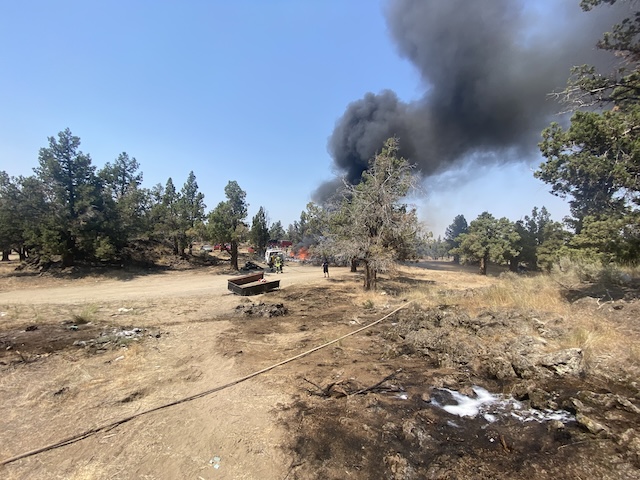Summer on your mind? Here’s how to keep your dog safe from deadly algae in Oregon.
Published 12:00 pm Friday, April 18, 2025
There’s nothing like an Oregon summer, but taking a dive into the cool, refreshing waters of the state’s rivers and lakes can be a death sentence for four-legged family members.
“Each year, we receive reports about dog illnesses or deaths linked to a water body that may be affected by cyanobacteria, but the deaths are often unexplained, or the cause of the death isn’t immediately known,” Linda Novitski, a recreational waters specialist with the Oregon Health Authority, said.
Cyanobacteria is a type of algae found in freshwater worldwide on the surface of water, suspended within the water or anchored into the sediment. Under the right conditions, the bacteria can multiply into blooms. Many of those blooms are harmless, but some can produce cyanotoxins that can make people and animals sick when ingested or inhaled.
Dogs are especially vulnerable
Trending
Due to their smaller size, dogs are especially vulnerable to cyanotoxins, and can get extremely ill or die within “minutes to hours of exposure to cyanotoxins by drinking the water,” according to the OHA.
In August 2024, Jax, a 3-year-old border collie owned by a Scappoose woman, started vomiting and having diarrhea after ingesting water off the northern point of Sand Island across from St. Helens. He then had a seizure and became unconscious, and died within the hour.
OHA collected water samples from the area a week later and found no harmful cyanobacteria blooms present, but the agency couldn’t rule out the possibility.
“Small pockets of water, within much larger systems, can accumulate bloom material, and that might be an ephemeral accumulation where we’re not going to catch it,” an OHA spokesperson said at the time. “It might be there one day, gone the next. We do our best.”
OHA launches new tool to report presence of cyanotoxins
In a statement issued April 17, the OHA announced that it will begin issuing warnings following reports of dog illnesses and deaths resulting from possible cyanotoxin exposure.
“These pre-emptive warnings will help us immediately take steps to inform the public about the possible presence of cyanobacteria in a water body,” Novitski said.
Trending
This marks a change in how the OHA reports on cyanotoxin dangers. The agency didn’t track dog deaths a year ago.
“OHA developed this warning system to make people aware of the issue with dogs and cyanotoxins,” OHA Public Health Communications Officer Tim Heider said. “The intent of these alerts is to use another tool in our tool kit to make sure that our lakes and rivers are safe for recreational use.”
Information on current advisories can be found on the OHA’s cyanobacteria bloom webpage at healthoregon.org/hab.
Symptoms of exposure
Dog owners should stay alert and watch their pets to make sure they don’t lick their fur after swimming or eat floating algae mats or dried crust along the shore, which may lead to cyanotoxin exposure.
If a dog is exposed to cyanotoxins, they may exhibit symptoms such as diarrhea, vomiting, breathing problems, difficulty walking or standing or loss of appetite. Once exposed, time is of the essence, and owners should get their pet to a veterinarian as soon as possible.
Small children should also be protected, and signs of human exposure to cyanotoxins may include diarrhea, cramps, vomiting, numbness, dizziness or fainting.
People with sensitive skin may also develop a red, raised rash when swimming in or around a bloom, although cyanotoxins aren’t known to be absorbed through the skin.
The algae can be harmful when ingested, which can happen while swimming, but it can also cause harm when water droplets are inhaled, which can happen during high-speed water activities that create spray, such as boating.
“Enjoying lakes and rivers is such an important part of the Oregon experience,” Novitski said. “To have fun and stay safe this season, protect small children and dogs by avoiding anything you think might be a cyanobacteria harmful algae bloom in the water or in a mat attached to the bottom of the lake or river.”
‘When in doubt, stay out’
Toxin testing is only available for some types of cyanobacteria, and only a fraction of Oregon waterways are monitored, so it’s important to know the signs of a bloom to prevent exposure.
Avoid areas where the water looks foamy, scummy, thick, pea-green or blue-green — those are signs that the water might not be safe for swimming. Thick, green or brownish-red mats may also be visible, as well as bright green clumps that may be suspended in the water.
The OHA has an online photo gallery to help community members identify signs of potentially harmful blooms.
Cyanotoxins can still exist in clear water, however. When a cyanobacteria bloom dies, it may release toxins into the clear water around it. Blooms can also be pushed into other areas, leaving toxins behind.
“Those who are unsure should follow OHA’s guidance of ‘When in doubt, stay out,’” the release said.
Camping, hiking, biking, picnicking and birdwatching can still be enjoyed in the area nearby if a body of water isn’t safe for swimming.









